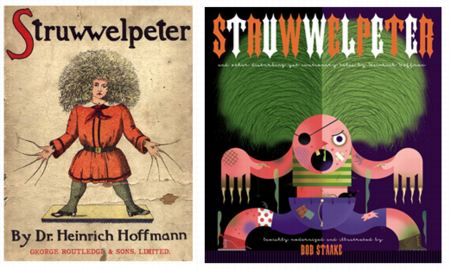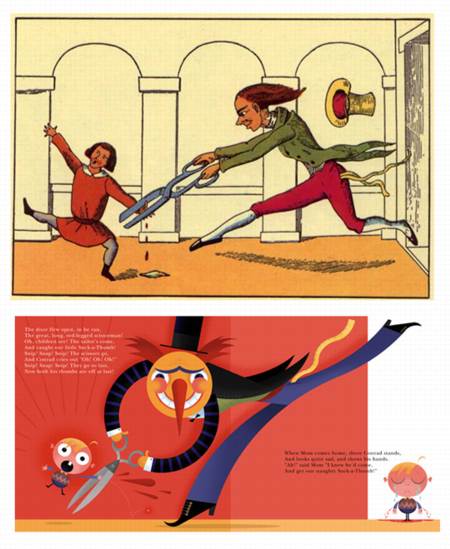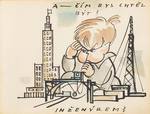
Holy crap, And I thought Bisphenol A hysteria compounded by equivocating corporate shills was scary.
Artist and prolific children's book illustrator Bob Staake ["Stack," as in "stack of titles to his name," btw] remembered all the tales of Der Struwwelpeter [Shockheaded Peter], a classic German children's book written by Dr. Heinrich Hoffmann in 1844, from his own childhood. And by "remembered," I mean "had seared into his impressionable child brain, where they would haunt his nightmares forever, unless he could get control of them by drawing them himself."
Staake created a modern visual and textual translation of Der Struwwelpeter in his signature comic style, which was published by Fantagraphics last year.
Staake told Pixelsurgeon:
When I read the book as a kid, I remember thinking "this had GOT to be a joke, right?", but I soon learned this was the German way of child-rearing; scare the crap out of your kids and let 'em know that if they don't eat all their peas, some weird looking clown will burst out from behind a curtain and slice their nose off with an ax.No kidding. One reviewer called it "'Scared Straight' for toddlers." Hoffman wrote the book as a Christmas present for his 3-year-old son. Three years old!

So in Germany, they use The Great Tall Tailor a gun-toting rabbit to condition their kids' behavior. In the US, we have, what? Santa Claus. And the Tooth Fairy. [Actually, they have Santa, too. And how.] Germany, the ball is in your court. please take a break from all your soccer-fuelled babymaking and explain what the hell is going on.
Staake made a great website for Der Struwwelpeter, and you can buy it there or from Amazon. [amazon]
Pixelsurgeon's interview with Bob Staake [pixelsurgeon]




> Actually, they have Santa, too.
Well, yes and no. We have Nikolaus Tag (kind of like Santa Claus Day) that is celebrated on the 6th of December. Kids would leave a boot outside their room and in the morning they would find it stuffed with candy and small gifts.
On Christmas we have the Christkind (Christ child if you will) that comes on Christmas Eve. The kids stay with grandparents in their rooms, listening to stories etc. While the parents decorate the tree and put the gifts under the tree. When all is done somebody rings a bell and the children are allowed to come into the living room to open the gifts. Small kids are made to believe that the Christkind did all the decorating and brought the presents. All this happens after a usual elaborate Christmas Eve dinner.
I can only speak for the region I grew up, though. In the next town down the road things are probably done quite differently.
A few words in regards Struwwelpeter. I used to own that book as a child. As an older child, I must say. I don't recall that we kids were supposed to learn something by being scared by books like this. It was really more entertainment. At least in my family a book like this was not used to say "cut your nails or the tailor will come and cut your fingers off".
[excellent info. I was actually referring to St Nick, who, in the book, covers some boys with ink for making fun of an actual black kid. -ed.]
We had Slovenly Peter (as ours was called) when I was a little kid (translated into English) and it was one of my favorite books. However, I did suck my thumb until I was thirteen, so I'm not sure how effective it was. I was also fascinated by all the Child ballads where people died, Tell Lara I Love Her and Teen Angel, and H.C.A.'s The Seven Swans so maybe this says more about me than how well Slovenly Peter works. That being said, I'm rushing right out to get this beautiful new version so my impending kid can read both.
The Tiger Lillies were in a musical adaptation of Shockheaded Peter that toured through NYC a couple of years ago. My wife took me as a birthday present - the soundtrack is available on CD:
http://tinyurl.com/2xc6g4
While I'm not German, I do think that all the gory / scary / death-filled tales that one reads as a child (at least in Europe, since American kids are completely shielded from anything remotely disturbing) do serve a function in helping little children process their deepest, darkest fears. That would explain why those tales have been around for hundreds of generations, and why we remember them so vividly as adults. I must say that I always smile when I see Grandma hiding under the bed in the American version of Little Red Riding Hood that my daughter was given. When I was little, Grandma was eaten up in one piece. I don't feel traumatized, but perhaps others are?
This kind of stuff isn't just restricted to Germany either. They have some fantastic children stories in the Czech Republic that are well worth trying to find.
No sugar coating, just telling kids how life really is, but in amusing cartoon format. What could be better?
I blame Disney. Cinderella is a much more dramatic story with the step sisters lopping off parts of their feet and then being pursued by a talking bird yelling, "Blood in shoe!"
I had Stuwwelpeter as a kid and it didn't scare me. I also loved the Brother Grimm Tales. But I remember that there is also a book called the anti-struwwelpeter by well known german cartoonist and illustrator Friedrich K. Waechter. It's from the german studet movement (68er Bewegung) and sort makes fun of the original.
I am currently a American student enrolled in a year-long program at a German University, and I am required to write a literary analysis of Struwwelpeter. When my class first started discussing "Der Struwwelpeter," I also thought that the morbid tales were a little too violent for young minds. However, as I formulated my analysis for my paper's argument, I realized that many American forms of children's entertainment are no less violent. For example, what scenerios commonly presented themselves in American cartoons or other children's books? (Take Warner Brother's "Looney Toons" as a prime example.) Although contemporary children's entertainment is gearing more towards pacifistic cartoons,books, etc, numerous examples can still be see that include material "inappropriate" for young audiences. (For example, the "Shrek" series contains many sexual connotations and drug references that may be considered "too mature" for young viewers.)
I am by no means condoning violence or other forms of deviance in children's entertainment, let alone defending the morbidness of Struwwelpeter (I mention above that upon my first reading of the book, I, too, was shocked). However, I would like to draw attention to the fact that that people from other cultures are increasingly willing to promote the benevolent behavior of their own culture by generalizing Germans as innately brutal and eager to exhibit violence at any chance possible. The implications of the article above appear to justify my perception.
So before jumping to a conclusion about any form entertainment, regardles of culture or origin, please avoid ethnocentric characterizations, lest you are also willing to take a microscope to the shortcomings of your own culture, as well.